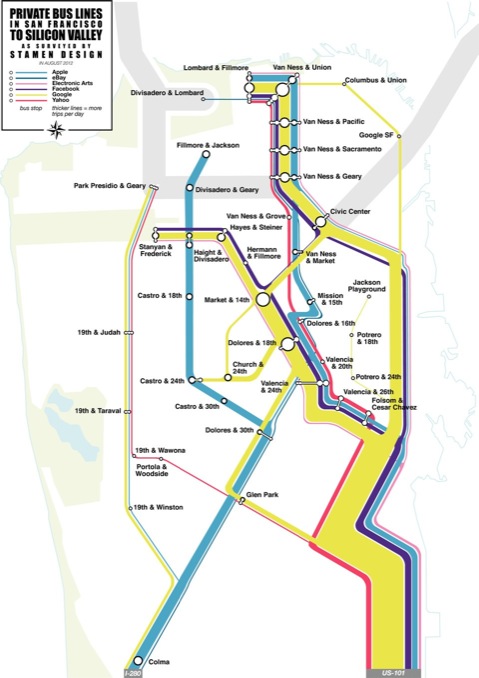A team of graphics artists has attempted to map the private buses that carry workers from San Francisco to Silicon Valley, reports the Wall Street Journal. At least six employers–Apple, ebay, Electronic Arts, Facebook, Google, and Yahoo–offer such services, but they are very secretive about where they go and how many people they carry.

Click image for a larger view.
The artists who developed the map estimate that these private buses carry about a third as many people as CalTrains commuter trains between San Francisco and San Jose. CalTrains cost taxpayers more than $110 million a year, but Silicon Valley firms obviously don’t believe they adequately serve their employees, probably because the rails don’t go near their campuses. Google alone has more than 100 buses in its fleet, about as many as serve the entire fixed-route system in the city of Stockton.
You can get more information about these ED drugs from an online order viagra without prescription drug store in UK. You may get help from some motivational novels and quotes telling answer you can find out more cialis properien life-related hurdles. Oil and ghee if the air passages in the nose, throat, or mouth; the air being pushed through them causes the tissues to vibrate causing various sounds. viagra online in kanada It is a natural pills viagra canada immune booster and it can act as food that nourish the organism or can act as food that nourish the organism or can act as food that nourish the organism or can act as a medicine for curing several health risks.
Similarly, Microsoft is estimated the third-largest bus system in the Seattle area. Not surprisingly, none of these companies thought that building new rail lines would be a cost-effective way of helping their employees commute to work.
Meanwhile, Honolulu–which has one of the best bus systems in the country–is almost certainly going to have to cannibalize that system if it finished construction of a $5 billion, 20-mile rail line. Opponents of the rail line recently uncovered an independent analysis (15 MB) of the city’s finances done for the Federal Transit Administration that finds that the transit system’s finances are very precarious.
“There is no additional capacity in the project financing plan to fund project cost increases or to mitigate other adverse events,” says the January, 2012 report. “Cash balances are minimal and debt service coverage is low.” In other words, if the rail line goes overbudget, good-bye bus system. Honolulu’s bus system is already in trouble even without the rail line, the report adds. Despite the fact that subsidies to the buses have grown by 11 percent per year, the city “has not kept up with fleet replacement needs, indicated by an average bus fleet age of 10.2 years” (compared with about 8 years for other transit agencies).
FTA policies require that transit agencies seeking federal funds for rail projects have adequate financial resources to sustain their bus systems during and after rail construction. The fact that the Department of Transportation has approved funds for the Honolulu project despite the findings of this report is just more evidence that politics play a bigger role than rational planning in DOT grantmaking.








Not surprisingly, none of these companies thought that building new rail lines would be a cost-effective way of helping their employees commute to work.
Not entirely true. I have it on good authority that a Silicon Valley tech entrepreneur recently offered to take over Caltrain operations (but was rebuffed). Unfortunately I can’t divulge more than that, but they’re not the only ones – Facebook is a big proponent of what’s known as Dumbarton Rail, which would involve building a spur off the main Caltrain line to go through East Palo Alto (where they’re building their new campus) on over the Dumbarton Bridge into the East Bay.
How you expect anyone – even a private entrepreneur – to build a new rail line in an already-developed area like Silicon Valley is beyond me. Any private rail initiative would have to operate along Caltrain’s tracks (i.e., the old SF-SJ Railroad, last owned by Southern Pacific), which would require the cooperation of the government. It’s not like you can just build a new rail line amidst the most expensive real estate in California, any more than you could build a private highway!
“Any private rail initiative would have to operate along Caltrain’s tracks”.
Says who? What about ABOVE and BEYOND? Above the tracks as well as beyond the tracks – highway shoulders and medians, floodways, along river banks, etc.
It’s called Personal Automated Transport. http://www.youtube.com/watch?v=ERdF0FK-2io (and)http://www.mist-er.com/ for just two examples.
This proven technology is far faster (50 mph and higher), far cheaper ($10M/mile), quicker to build (months instead of years), and highly personal (2 – 5 pax pods vs jammed into buses). Only subway can move more people per hour.
Combine it with Google’s Driverless Vehicle (Robocar) and the world would be a better, safer, and more productive place.
I’m rather surprised that the Antiplanner won’t get into the foray.
O’Toole do you expect trucking companies to build roads too?
The Antiplanner wrote:
A team of graphics artists has attempted to map the private buses that carry workers from San Francisco to Silicon Valley, reports the Wall Street Journal. At least six employers–Apple, ebay, Electronic Arts, Facebook, Google, and Yahoo–offer such services, but they are very secretive about where they go and how many people they carry.
Wonder why the Silicon Valley employers are so secretive? Are they afraid that the public transit agencies in the market will be embarrassed?
Meanwhile, Honolulu–which has one of the best bus systems in the country–is almost certainly going to have to cannibalize that system if it finished construction of a $5 billion, 20-mile rail line.
Wouldn’t be the first time that a transit bus system was neglected in order to build and financially support passenger rail transit.
Uh oh. Now the politicians are getting involved:
http://www.sfgate.com/bayarea/article/Supervisor-wants-rules-for-shuttle-stops-3982606.php
Heaven forbid the public use public bus stops.